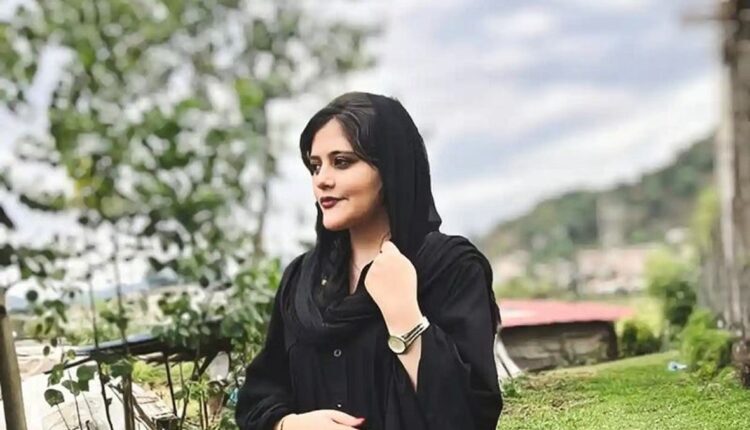Iranian authorities daunted by Mahsa Amini’s image
QAMISHLI, Syria (North Press) – It is beyond doubt that Mahsa Amini had died, however, Mahsa has turned into an apparition that appears everywhere perturbing Iranian authorities and raising expectation on the future of the autocratic leadership in the country.
With slogans chanting “Death to the Dictator,” and banners raised reading “Women, Life and Freedom” protests, mostly held at night, go on for the second week in a row. Implicitly, the dictator is a reference to the Supreme Leader Ayatollah Ali Khamenei whose portraits are widely seen torn down or set on fire by protesters. The banner shows how women are engaged in the events.

Mahsa Amini, 22, who comes from the Kurdish province of Saqez in the predominant Kurdish areas in Iran known otherwise as Eastern Kurdistan, was detained by the morality police at the train station as she was (with her family) on a visit to the capital Tehran, on September 13 in Tehran for “wearing inappropriate clothing.”
Three days later, Amini died in hospital causing widespread speculation on the cause of her death. While Iranian authorities claim Amini died of heart failure. The funeral procession of Amini at Aychi’s turned into a protest.
With the death of Amini that sparked unprecedented and even unexpected protests neither in Iran nor outside the Islamic Republic, the case has surpassed the death of the Kurdish woman Mahsa (Zhina) Amini who was allegedly killed by morality police. It has become a national one.
“Today is not just about Mahsa, but it’s also to show our 43-year-old hatred of the Islamic Republic. This is why we’re here today and what we’re seeing in Iran is a big demonstration, and if I may say, a revolution that is happening,” Mahboubeh Moradi, an Iranian activist living in France, said in a gathering held in the central Place du Chatelet in the French capital Paris on Saturday.
Up to now, Amini’s death is a debatable one. Two different versions are told. “The results of observations, talking with those who were on the scene, receiving reports from relevant bodies and other investigations showed that late Ms. Amini was not beaten, Iranian Interior Minister Ahmad Vahidi told state-run IRNA reported. Raisi himself said early coroner’s findings found no signs of beating.
The Kasra Hospital in Tehran, where Amini was taken, said Mahsa was admitted without ‘vital signs.’ However, another account of the story is being told elsewhere. The family of Amini assuredly said Mahsa was beaten to death.
“It is not clear how she was beaten. The women who were in the ambulance said that she was hit on the head,” Amjad Amini, Mahsa’s father, told the Erbil-based media outlet Rudaw, adding that relevant authorities had refused to give him the autopsy for his daughter’s death.
The morality police, known officially as Guidance Patrol, tasked with enforcing the Islamic Republic’s strict dress code. It is claimed that since the coming into power a year ago, President Ebrahim Rais has assigned the unit with more privileges and powers (repression).
The case has garnered wide spread condemnation to the death and sympathy to the Amini family and Iranian protesters especially women.
While at home some 43 cities (including Tehran) witness protests with women largely being represented, protests abroad have been held in solidarity with Iranian women in Athens, Berlin, Brussels, Istanbul, Madrid, New York and Paris, among other cities. The traditionally conservative city of Mashhad has also witnessed protests. Mashhad is the city birthplace of Khamenei.
This comes at a time where much pressure is being put on Iran following the failure of talks regarding Iran 2015 nuclear deal which was reversed in 2018 by the US President Donald Trump seeking a “better deal.”
After ten days of protests the toll of fatalities has risen. While authorities admit to 41 deaths including security forces, figures are expected to much higher than that. On Sunday, the Norway-based Iran Human Rights (IHR) said that the death toll was at least 57.
On September 23, Amnesty International said that at least 30 people, including four children were killed. However, internet blackouts make it very difficult to ascertain the deaths and injuries.
However, amid internet blackout, many concerns are raised that much repression is being taking place by authorities.
Iranians living abroad voiced fears as they could not contact their relatives living at home.
“[We are] concerned about reports of peaceful protests being met with excessive use of force leading to dozens of deaths and injuries,” UN Secretary General Antonio Guterres said calling for an investigation led by “independent competent authority.”
Footage has shown women removing their headscarves and burning them in an act of defiance of the local authorities.
As a precursor to more severe crackdown, pro-government rallies took to the streets following Friday prayers. On Sunday, people loyal to the government took to the streets again concentrated largely in the capital.
On September 22, the United Nations High Commissioner for Human Rights said UN experts strongly condemned the use of physical violence against women in Iran by state authorities. The Committee to Protect Journalists said at least 17 journalists were arrested.
On Sunday, Iran’s Judiciary chief, Gholamhossein Mohseni Ejei, emphasized the need for “decisive action without leniency” against the core instigators of the “riots.”
With the case being mentioned at the United Nations General Assembly 77th session wrapped up in New York days ago, and with the rerun to the country of Raisi, following his trip to the UNGA in New York, events could take another direction.

